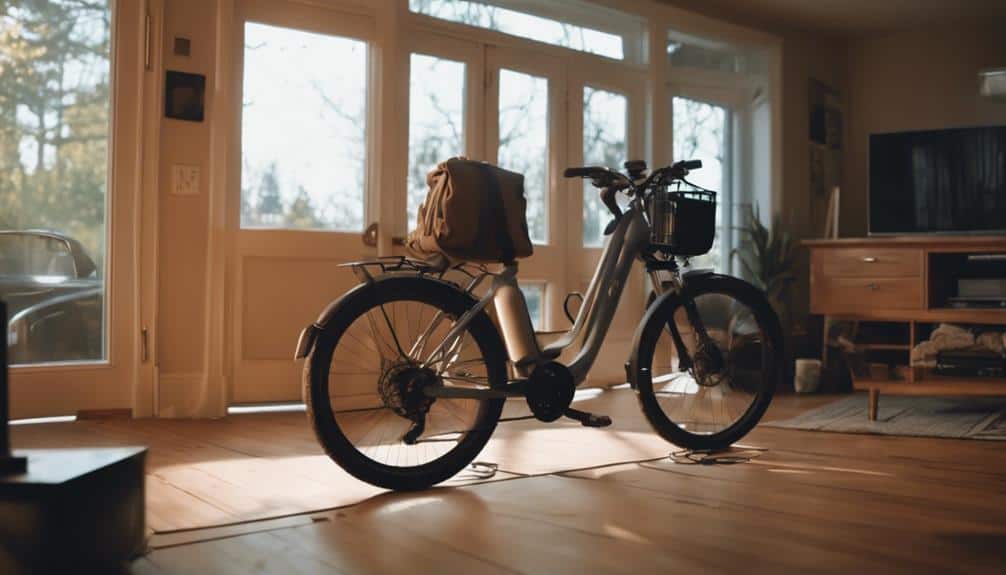To lower your carbon footprint at home, switch to energy-efficient appliances for reduced energy consumption. Opt for sustainable transportation like electric cars or public transit to decrease greenhouse gas emissions. Install low-flow faucets and fix leaks to minimize water usage and contribute to conservation efforts. Start composting and recycling to reduce waste production and minimize landfill contributions. Consider eco-friendly home improvements with green materials and energy-saving lighting. These simple changes can make a big difference in reducing your environmental impact and greenhouse gas emissions. Embracing these practices can help you create a more sustainable lifestyle at home.
Key Takeaways
- Use energy-efficient appliances to reduce electricity consumption and lower carbon emissions.
- Opt for sustainable transportation options like electric cars or public transit to decrease carbon footprint.
- Install water-efficient fixtures and appliances to conserve water and reduce environmental impact.
- Start composting and prioritize recycling to minimize waste production and lower carbon footprint.
- Make eco-friendly home improvements with green materials and energy-saving technologies to lessen environmental impact.
Energy-Efficient Appliances
By investing in energy-efficient appliances, you can greatly reduce your household's carbon footprint while also saving on energy costs in the long run. Energy saving practices have become increasingly important in today's world, with individuals looking for ways to decrease their environmental impact. Green technology advancements have led to the development of appliances that consume less energy while maintaining high performance levels. When you opt for energy-efficient refrigerators, washing machines, dishwashers, and other household appliances, you contribute to a more sustainable environment.
Energy-efficient appliances are designed to use less electricity or gas compared to traditional models, thereby reducing the amount of energy required to operate them. This not only helps in lowering your utility bills but also decreases the demand for energy production, which often involves the burning of fossil fuels. By making conscious choices to switch to energy-efficient appliances, you actively participate in mitigating climate change and promoting a greener future for generations to come.
Sustainable Transportation Options
To lessen your carbon footprint further, contemplate exploring sustainable transportation options that prioritize environmental conservation. One effective way to achieve this is by opting for electric cars. Electric vehicles produce zero tailpipe emissions, greatly reducing greenhouse gas emissions compared to traditional gasoline-powered cars. With advancements in technology, electric cars now offer competitive ranges and fast charging capabilities, making them a practical choice for daily commutes and longer trips. Additionally, many governments provide incentives such as tax credits or rebates to encourage the adoption of electric vehicles, further offsetting the initial cost.
Another sustainable transportation option to ponder is utilizing public transit options. Buses, trains, trams, and subways are more energy-efficient per passenger mile compared to individual cars, reducing overall carbon emissions. By choosing public transportation over driving alone, you can contribute to decreased traffic congestion and air pollution. Additionally, carpooling or ridesharing services offer similar benefits by maximizing vehicle occupancy and reducing the number of cars on the road. Embracing sustainable transportation options like electric cars and public transit can make a notable impact in lowering your carbon footprint.
Reduced Water Consumption
Reducing water consumption in your daily routines can greatly contribute to environmental sustainability and resource conservation. By implementing water-saving tips and eco-friendly plumbing practices, you can make a substantial impact. Here are some simple yet effective ways to lower your water usage:
- Install low-flow faucets and showerheads: These fixtures can greatly reduce water usage without compromising water pressure, leading to substantial water savings over time.
- Fix leaks promptly: Even a small leak can waste a substantial amount of water if left unattended. Regularly check for leaks in faucets, toilets, and pipes, and repair them promptly to prevent unnecessary water wastage.
- Opt for efficient appliances: When it's time to upgrade your appliances, choose water-efficient models such as dishwashers and washing machines. These appliances are designed to use less water while maintaining an excellent performance.
Implementing these water-saving practices not only contributes to environmental conservation but also helps lower your utility bills in the long run.
Waste Reduction and Recycling
Lowering your water consumption is just one part of the puzzle when it comes to creating a more sustainable home; now let's shift our focus to waste reduction and recycling.
One effective way to reduce waste is by starting a compost bin for organic materials like food scraps and yard waste. Composting benefits the environment by diverting these materials from landfills where they generate harmful greenhouse gases. It also produces nutrient-rich soil that can be used to nourish your garden, closing the loop on organic waste.
When it comes to plastic waste, consider switching to reusable alternatives like stainless steel water bottles, cloth grocery bags, and glass food storage containers. These plastic alternatives not only reduce the amount of plastic waste ending up in landfills and oceans but also help minimize the production demand for new plastic products.
Eco-Friendly Home Improvements
Think about incorporating energy-efficient appliances and solar panels into your home to reduce environmental impact and save on utility costs. When looking to make eco-friendly home improvements, there are several options to ponder:
- Green Building Materials: Opt for sustainable materials like bamboo flooring, recycled glass countertops, or reclaimed wood for your renovation projects. These materials have a lower impact on the environment compared to traditional options.
- Energy-Saving Lighting: Switch to LED bulbs or compact fluorescent lamps (CFLs) to reduce energy consumption and lower your electricity bills. These lighting options aren't only efficient but also last longer than traditional incandescent bulbs.
- Smart Home Technology: Install smart thermostats, lighting systems, and appliances that can be controlled remotely to optimize energy usage in your home. This technology allows you to monitor and adjust your energy consumption, leading to savings in the long run.
Conclusion
To sum up, by incorporating energy-efficient appliances, sustainable transportation options, decreased water consumption, waste reduction, and recycling, and eco-friendly home improvements, you can greatly lower your carbon footprint at home.
Remember, every small change you make adds up to make a substantial impact on the environment.
So, take the first step towards a greener lifestyle today and watch as your home becomes a beacon of sustainability in a world filled with darkness.




